“I no longer believe we will get out of this alive. There is not a home in Gaza that is safe”. An Al Jazeera reporter wrote this on Wednesday (11 October) as Israel continues its heavy bombardment of the Gaza Strip in retaliation to Hamas’ attacks over the weekend. Many residents of the Gaza Strip are of the same opinion and add that if it’s not an Israeli airstrike that will kill them, it will be the lack of fuel and electricity that will. After all, Gaza’s sole power plant stopped working after the fuel needed for generating electricity ran out on Wednesday. “Gaza is currently without power,” the head of the Gaza power authority, Galal Ismail, told CNN. What will it be like to live without electricity and fuel? How are Gazans, who have no way out, coping with this life-threatening situation?
Gaza goes dark On Wednesday, the Gaza Ministry of Energy announced that the enclave had lost all electricity after the only power station ran out of fuel and had to shut down. “The only power plant in the Gaza Strip stopped functioning at 2 pm (4.30 pm IST),” Gaza Energy Authority chief Jalal Ismail said. The move comes after Israel on Monday ordered a
complete siege of Gaza
as part of their retaliation against the Hamas attacks carried out over the weekend. This means that Israel has blocked supplies of food, water, fuel to the area, effectively cutting off the residents from the rest of the world. The Strip, which is inhabited by 2.3 million people, making it one of the most densely populated areas in the world, has now plunged into darkness as the mains electricity has shut down. And even though Gazans use power generators, the fuel needed for them is running out. This means that there will only be a few hours of electricity left in them too. [caption id=“attachment_13237552” align=“alignnone” width=“640”]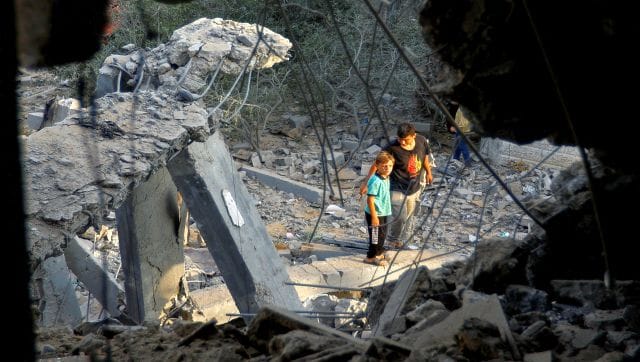 The heavy Israeli bombardment in the Gaza Strip since Monday has reduced the area to debris and rubble. As of Day 6 of the war, the death toll in the region has increased to over 1,000. Reuters[/caption] [caption id=“attachment_13237552” align=“alignnone” width=“640”]
The heavy Israeli bombardment in the Gaza Strip since Monday has reduced the area to debris and rubble. As of Day 6 of the war, the death toll in the region has increased to over 1,000. Reuters[/caption] [caption id=“attachment_13237552” align=“alignnone” width=“640”] The heavy Israeli bombardment in the Gaza Strip since Monday has reduced the area to debris and rubble. As of Day 6 of the war, the death toll in the region has increased to over 1,000. Reuters[/caption] “This threatens to plunge the Strip into complete darkness and make it impossible to continue providing all basic life services, all of which depend on electricity, and it will not be possible to operate them partially with generators in light of the prevention of fuel supplies from Rafah Gate,” said a statement issued by Gaza’s authorities on Wednesday. “This catastrophic situation creates a humanitarian crisis for all residents of the Gaza Strip,” it added. ‘A humanitarian crisis’ Israel’s complete siege to Gaza has made living almost impossible for its people. And with the power plant shutting down, the situation in the hospitals will only exacerbate. Hospitals are already struggling to cope with the influx of patients owing to Israel’s heavy bombardment in the area. As of Day 5 of the war, the toll in Gaza had breached the 1,000-mark, with the number only climbing further in the days to come. Also, another 5,000-odd people have been injured and rushed to hospitals. [caption id=“attachment_13237502” align=“alignnone” width=“640”]
The heavy Israeli bombardment in the Gaza Strip since Monday has reduced the area to debris and rubble. As of Day 6 of the war, the death toll in the region has increased to over 1,000. Reuters[/caption] “This threatens to plunge the Strip into complete darkness and make it impossible to continue providing all basic life services, all of which depend on electricity, and it will not be possible to operate them partially with generators in light of the prevention of fuel supplies from Rafah Gate,” said a statement issued by Gaza’s authorities on Wednesday. “This catastrophic situation creates a humanitarian crisis for all residents of the Gaza Strip,” it added. ‘A humanitarian crisis’ Israel’s complete siege to Gaza has made living almost impossible for its people. And with the power plant shutting down, the situation in the hospitals will only exacerbate. Hospitals are already struggling to cope with the influx of patients owing to Israel’s heavy bombardment in the area. As of Day 5 of the war, the toll in Gaza had breached the 1,000-mark, with the number only climbing further in the days to come. Also, another 5,000-odd people have been injured and rushed to hospitals. [caption id=“attachment_13237502” align=“alignnone” width=“640”]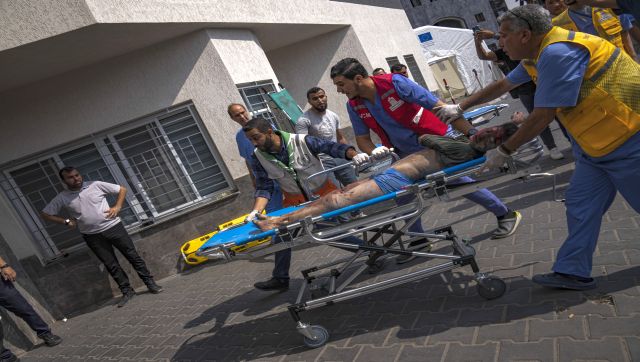 A person injured in an Israeli bombing is brought to a hospital in Gaza City. Lack of electricity has hospitals turning away patients in the area. AP[/caption] However, medical personnel in hospitals are worried about tending to patients without any electricity. At the heart of the crisis are the intensive care units, where thousands of injured people are struggling for their lives. A significant number of them rely on electricity-powered oxygen generators to breathe and survive. Hassan Khalaf, the medical director of Al-Wafa Hospital in Gaza City told _Al Jazeer_a that the generators have a life of only “maximum: a few days”, and may be as short as a day or two. The doctor said there were about 1,100 patients who rely on dialysis machines for survival in Gaza. Medical-humanitarian teams from the international Medecins Sans Frontieres (MSF) echoed the remarks. Guillemette Thomas, MSF’s medical co-ordinator of Palestine, told Sydney Morning Herald, “The situation is catastrophic. Many of our staff who have been working in Gaza… all say that this situation is the worst that they have ever seen.” [caption id=“attachment_13237522” align=“alignnone” width=“640”]
A person injured in an Israeli bombing is brought to a hospital in Gaza City. Lack of electricity has hospitals turning away patients in the area. AP[/caption] However, medical personnel in hospitals are worried about tending to patients without any electricity. At the heart of the crisis are the intensive care units, where thousands of injured people are struggling for their lives. A significant number of them rely on electricity-powered oxygen generators to breathe and survive. Hassan Khalaf, the medical director of Al-Wafa Hospital in Gaza City told _Al Jazeer_a that the generators have a life of only “maximum: a few days”, and may be as short as a day or two. The doctor said there were about 1,100 patients who rely on dialysis machines for survival in Gaza. Medical-humanitarian teams from the international Medecins Sans Frontieres (MSF) echoed the remarks. Guillemette Thomas, MSF’s medical co-ordinator of Palestine, told Sydney Morning Herald, “The situation is catastrophic. Many of our staff who have been working in Gaza… all say that this situation is the worst that they have ever seen.” [caption id=“attachment_13237522” align=“alignnone” width=“640”]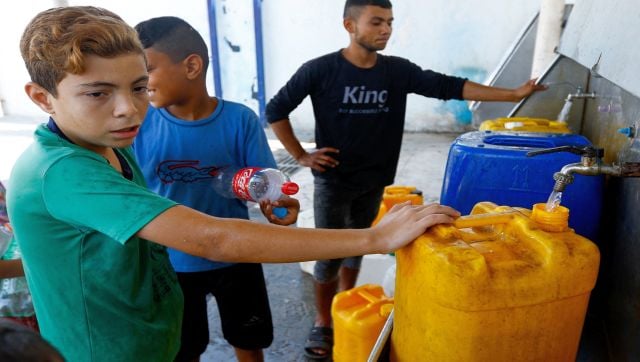 Palestinian children gather to fill bottles with water from public taps amid the conflict with Israel in Khan Younis, in the southern Gaza Strip. Reuters[/caption] But it goes beyond just hospitals. Without electricity, refrigerated food – which has been a lifeline until now for the people – is on the verge of expiration. With no food being allowed into the region and the area being levelled in airstrikes, Gazans will soon be left with no food, forcing them to go hungry. The loss of the power plant will also have an impact on clean water supply and sanitation, according to Israeli rights groups Gisha. With no electricity, the desalination plants won’t be able to work, leading to a shortage of drinking water. Sewage disposal will also not work. Moreover, accessing money through ATMs will also cease, owing to the lack of power. Also, communication lines will cease to function, cutting off the people of Gaza from the rest of the world. Foreign and local journalists in the region are also facing troubles as they are unable to charge their equipment. Many are relying on personal power banks, which too will soon run out of battery. [caption id=“attachment_13237542” align=“alignnone” width=“640”]
Palestinian children gather to fill bottles with water from public taps amid the conflict with Israel in Khan Younis, in the southern Gaza Strip. Reuters[/caption] But it goes beyond just hospitals. Without electricity, refrigerated food – which has been a lifeline until now for the people – is on the verge of expiration. With no food being allowed into the region and the area being levelled in airstrikes, Gazans will soon be left with no food, forcing them to go hungry. The loss of the power plant will also have an impact on clean water supply and sanitation, according to Israeli rights groups Gisha. With no electricity, the desalination plants won’t be able to work, leading to a shortage of drinking water. Sewage disposal will also not work. Moreover, accessing money through ATMs will also cease, owing to the lack of power. Also, communication lines will cease to function, cutting off the people of Gaza from the rest of the world. Foreign and local journalists in the region are also facing troubles as they are unable to charge their equipment. Many are relying on personal power banks, which too will soon run out of battery. [caption id=“attachment_13237542” align=“alignnone” width=“640”]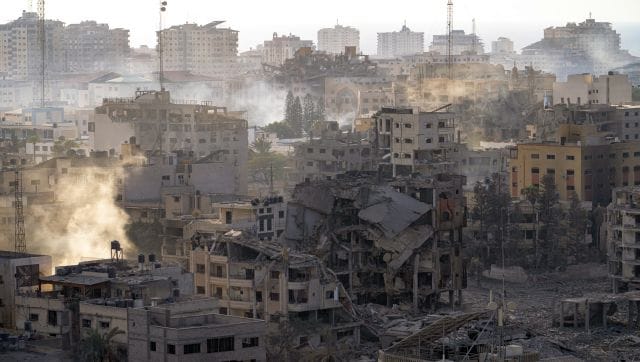 Destruction from Israeli aerial bombardment is seen in Gaza City. AP[/caption] Help needed, now Doctors at hospitals in Gaza lamenting the situation have called on Israel to allow for emergency supplies to be directed into the region. Humanitarian organisations have also called for international aid for Gaza. Hussein al-Sheikh, secretary-general of the executive committee of the Palestine Liberation Organisation (PLO), urged the international community “to intervene urgently to stop the aggression, allow the entry of relief materials, and restore electricity and water, because the Gaza Strip is facing a major humanitarian catastrophe”. Reacting to the situation, the United Nations High Commissioner for Human Rights Volcker Turk said Israel’s refusal to supply food, fuel and other essential commodities to the Gaza Strip was prohibited under international law. Even the European Union has criticised the total siege on Gaza. Josep Borrell, the EU’s foreign policy chief, on Tuesday said Israel was violating international law. The United Nations spokesman Stephane Dujarric said Wednesday, “Citizens need protection,” adding, “We want to see a humanitarian corridor.” The United Nations also said on Thursday that more than 338,000 people have been displaced in Gaza. And even though voices for a humanitarian corridor to let Palestinians leave the conflict zone have grown louder, the reality is that they have nowhere to go. This is because the
only crossing
, the Rafah Gate, is closed as of now. In fact, Reuters reported on Tuesday that Israeli bombardments had hit the area of the Rafah border crossing between the strip and Egypt. With inputs from agencies
Destruction from Israeli aerial bombardment is seen in Gaza City. AP[/caption] Help needed, now Doctors at hospitals in Gaza lamenting the situation have called on Israel to allow for emergency supplies to be directed into the region. Humanitarian organisations have also called for international aid for Gaza. Hussein al-Sheikh, secretary-general of the executive committee of the Palestine Liberation Organisation (PLO), urged the international community “to intervene urgently to stop the aggression, allow the entry of relief materials, and restore electricity and water, because the Gaza Strip is facing a major humanitarian catastrophe”. Reacting to the situation, the United Nations High Commissioner for Human Rights Volcker Turk said Israel’s refusal to supply food, fuel and other essential commodities to the Gaza Strip was prohibited under international law. Even the European Union has criticised the total siege on Gaza. Josep Borrell, the EU’s foreign policy chief, on Tuesday said Israel was violating international law. The United Nations spokesman Stephane Dujarric said Wednesday, “Citizens need protection,” adding, “We want to see a humanitarian corridor.” The United Nations also said on Thursday that more than 338,000 people have been displaced in Gaza. And even though voices for a humanitarian corridor to let Palestinians leave the conflict zone have grown louder, the reality is that they have nowhere to go. This is because the
only crossing
, the Rafah Gate, is closed as of now. In fact, Reuters reported on Tuesday that Israeli bombardments had hit the area of the Rafah border crossing between the strip and Egypt. With inputs from agencies
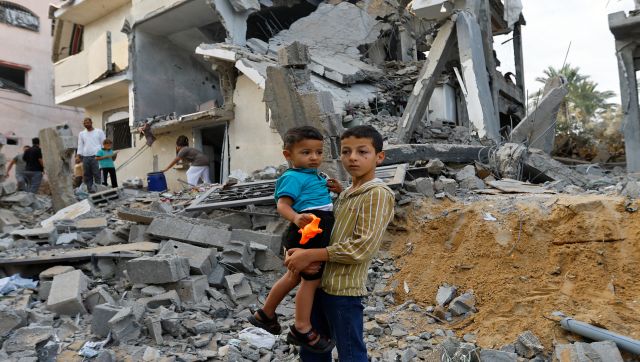)